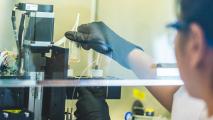A pair of food tech startups have teamed up to create what they say are the world’s first lab-grown fish filets — and they used a 3D printer to serve them.
The challenge: Demand for seafood is expected to nearly double by 2050 due to a growing population and increasing incomes, but overfishing, climate change, ocean pollution, and other factors pressure the seafood industry’s ability to satisfy the world’s hunger for fish.
Even if industry can source all the seafood we need from the ocean and fish farms, current fishing practices can harm the environment, via greenhouse gasses and marine ecosystem destruction, problems only likely to increase as the industry grows.
“We showcased a cultivated product that flakes, tastes, and melts in your mouth exactly like excellent fish should.”
Mihir Pershad
Lab-grown fish: Rather than continuing to rely on our current sources of seafood, a handful of startups think we should also grow some of the fish we want to eat from cells in labs.
Two of those companies — Steakholder Foods in Israel and Umami Meats in Singapore — have now teamed up to create a cultivated fish filet prototype, which they recently served to a handful of special guests, including Israeli Prime Minister Benjamin Netanyahu.
“We are delighted to have produced the world’s first whole filet cultivated fish in partnership with Steakholder Foods,” said Mihir Pershad, CEO of Umami Meats. “In this first tasting, we showcased a cultivated product that flakes, tastes, and melts in your mouth exactly like excellent fish should.”
Making the meat: Making lab-grown fish (or any meat) starts with cells from living animals. The cells are then combined with nutrients in machines called “bioreactors” that produce the ideal conditions for the cells to multiply.
Because the cells that come out of bioreactors are molecularly identical to those found in “real” meat, they’re a great match for flavor. However, they aren’t structured like real meat, so the texture is often still lacking.
But Steakholder has developed a technique for turning lab-grown fish cells into a “bioink” that can be 3D printed into ready-to-cook filets.
Looking ahead: It’s not clear how much it cost Steakholder and Umami to produce their fish filets, and for lab-grown fish to be able to help meet future seafood demand — or even survive commercially at all — the cost will need to be at least somewhat comparable to the price of fish from the sea and farms.
We shouldn’t have to wait long for more information on the sustainable seafood alternative, though, as the companies say they will announce their plan to bring the fish to market “in the coming months.”
We’d love to hear from you! If you have a comment about this article or if you have a tip for a future Freethink story, please email us at [email protected].






